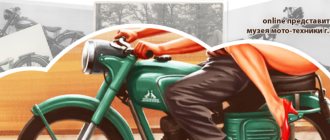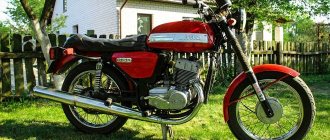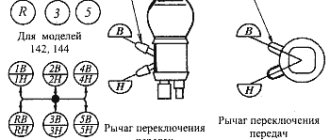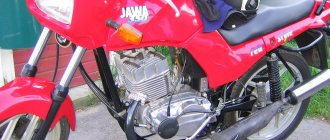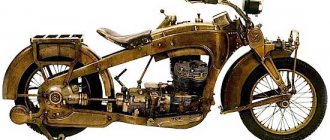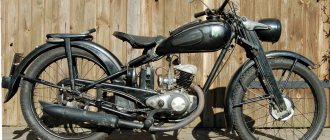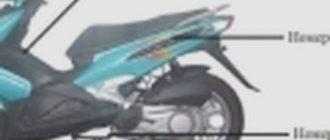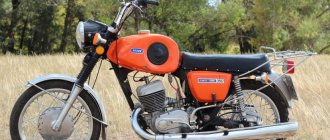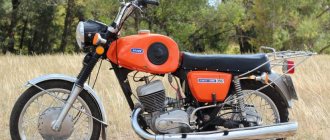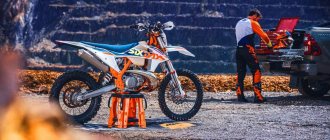To this day, debates about which is better - a car or a motorcycle - continue to rage. But these debates in the 20th century largely concerned developed capitalist countries, where the level of earnings made it possible to choose between a four-wheeled or two-wheeled vehicle.
Did you have a Soviet motorcycle?
NOT REALLY
In the Soviet Union, the picture was simpler - if you can, buy a car, since there is a lot of choice, if you don’t have enough money, then buy a motorcycle.
The history of the legendary Jawa motorcycle
Who among us doesn’t remember the beautiful cherry-colored motorcycles from Czechoslovakia? We remember what the Java model was famous for, why it was loved more than the Soviet Izha, where its owners hung out in the USSR and why the Czech brand lost its world leadership.
In the post-war years, Europe's recovering economy needed simple, cheap transport - so the first small cars appeared. Everyone is well aware of the Citroen 2CV and VW Kaffer (aka “Beetle”), which have won the hearts of Europeans. In the Land of the Soviets, the automobile industry had not yet fully formed, and the production of cheap small cars was established at the MZMA plant (later AZLK). But what is accessible to a European is dear to a Soviet person. That is why motorcycles were popular in our country.
The motorcycle industry in the USSR was more or less developed before the war. Since 1928, quite interesting models of the Izh brand were produced in Udmurtia, including the large models Izh-1 and Izh-2, which were very advanced at that time, with large V-shaped “twos” with a volume of 1,200 cubic centimeters.
But all plans for mass production of motorcycles remained plans - the war began. Well, after the war, the Soviet leadership decided not to invent the bicycle... that is, the motorcycle, but to use the trophies.
Both IzhMash and the Minsk Motorcycle Plant received German drawings and equipment from the DKW plant. Izhevsk residents have mastered the production of more impressive equipment - the Izh-350 with a two-stroke engine of 350 cubic meters. The bicycle factory from Minsk received a light motorcycle with a 125 cc engine. Later, the Degtyarev Plant, which created the Voskhod brand, joined the production of motorcycles based on DKW drawings.
Motorcycle "Izh"-350 1946-1951.
In the Soviet provinces they preferred primitive equipment, which was not only easy to repair... but which, ideally, could not be maintained at all until something fell off. In the villages, “Izhi”, “Voskhody” and “Minski” were rolled away “for slaughter”.
The urban public preferred foreign cars, and not at all out of foppishness. MZ - from the GDR, Pannonia - from Hungary and, of course, the Czech Jawa. This is what will be discussed in this article.
Birth of a legend
The history of cherry motorcycles, familiar from childhood, begins in 1929, when Czech entrepreneur Frantisek Janecek begins licensed production of Wanderer motorcycles at his factory. He didn’t think much about the name of his motorcycles and collected the name of the brand from the first letters of his last name and the name of the motorcycle. It turned out JaWa.
The first motorcycle produced
The heavy German cycle with a half-liter engine was expensive and therefore not popular. Therefore, in 1932, the Jawa plant showed the world its own development - a light motorcycle with a 175 cc engine, and in 1934-35 it launched production of models with 250 and 350 cc engines. There were many interesting moments in the pre-war history of the brand, but Jawa won a complete victory over its customers in 1946.
The first peaceful year after the war. Countries are recovering from shocks. An exhibition of automobile and motorcycle equipment is taking place in Paris. Most companies present their pre-war developments, sometimes hastily modified. And the excitement around the Jawa stand continues. The Czechs presented a completely new motorcycle!
During the occupation of the Czech Republic, the Jawa plant was engaged in the repair and maintenance of German motorcycles. And, of course, it was impossible to carry out any of our own developments at the plant. But the engineers and mechanics of the plant, secretly from the German management, developed, tested, prepared documentation for serial production, and even produced slightly less than a thousand assembly kits for the production of a motorcycle that had little in common with a typical two-wheeled vehicle of the 40s.
"Java Perak"
Two-stroke 250 engine with reciprocating-variable scavenging, four-speed gearbox with automatic clutch release, front telescopic forks and rear spark plug suspension, single frame made of square steel tubes... For those times - a real breakthrough.
The design of the motorcycle also stood out from others. A developed headlight lining that smoothly flows into the fork stays, a teardrop-shaped gas tank with chrome-plated sides... The look was completed by chrome-plated mufflers in the fishtail style. And most importantly - what accuracy! All wiring is flush, and even the carburetor is covered with an aluminum casing.
Of course, such a modern, beautiful and also inexpensive motorcycle immediately found its buyer. In 1948, in addition to the 250 model, the two-cylinder 350 model was released. With these two models, Jawa Perak 250 and 350, the modern history of the brand began.
The legend goes to the Union!
In 1953-54, the Perak, which had not yet become obsolete, was replaced by an improved model. By keeping the 250 and 350 engines without major modifications and seriously modifying the chassis, Jawa ensured its fame and popularity for several more decades.
The new model had a frame made of rectangular pipes of a similar design and a more modern chassis. The front suspension was modernized without significant changes, but the rear suspension was completely updated. The place of the spark plug suspension was taken by a pendulum suspension with a pair of telescopic shock absorbers, to which the motorcycle owes the name “Kivachka”. In the Soviet Union, the name “Chekushka” first took root because of its quarter-liter volume, and with the advent of new models, the name “Old Woman” came into use.
The styling of the motorcycle has also undergone significant changes. The minimalism of the 40s was replaced by a style comparable to modern cruisers. A developed headlight casing that almost flows into the now signature teardrop-shaped tank, streamlined shapes of the power unit that transform into a characteristic, purely decorative casing of the seat space. A double seat in the shape of a guitar and deep fenders in the fashion of those years. And again fishtail mufflers.
But the future “Old Woman” appeared before the Soviet public in a different form: with cigar-shaped mufflers. In the USSR, "Java" was sold only in one color, but in fact, all over the world there were various factory paint options: several two-color schemes and single-color schemes - white, black, scarlet and our well-known cherry.
Extremely reliable, unpretentious, easy to maintain, but at the same time comfortable in a European way. And not as “oaky” as the Soviet “Izhi”! “Java” had a lot to love. The Izh-56, produced at the same time, although it belonged to the same class, weighed 20 kilograms more, drove 15 km/h slower and was much inferior in driving performance to its Czech competitor. Therefore, despite the price of 600 rubles, versus 500 for Izha, Jawa has become extremely popular in cities.
"Java" 350 "Californian"
Jawa lovers' parties in the USSR
All major cities of our vast Motherland had their own branded Jawa spare parts store. By the end of the 50s, cherry motorcycles were such a common sight on the road that their owners began to get together regularly. Traditionally, the meeting place was the Java spare parts store.
They came there, as they would say now, just to hang out. Looking at neat boxes with equally neat spare parts, free of casting defects and scale, with straight edges, was beyond the strength of most dealers.
Also, for those who were especially curious, there were posters in stores with pictures of the coveted “Javs” that were not supplied to this country. For example, Jawa 250/350 Automatic with automatic centrifugal clutch (clutch lever was missing as a class).
You could also see a picture of Jawa with the postscript Oilmaster - with a system for mixing oil and gasoline that was difficult to set up and maintain and therefore was not supplied to the USSR. Yes Yes! Europe and America were full of motorcycles for which you didn’t have to painfully mix gasoline and oil yourself. There were also posters with JawaCalifornian for the American market with a completely different look. In part, these pictures gave impetus to tuning and customizing motorcycles.
"Java" 350 "Californian". The tubes from the Oilmaster system are clearly visible
Owner classification
Around the store, people gathered in flocks based on their interests. They were all fundamentally different for one large company.
The calmest were the “non-club” people. They simply quietly and peacefully drove up to the store, said hello to their friends and went on their way. It is useless to describe their motorcycles, because they were “completely stock.” At most, mirrors and turn signals could be screwed on.
The hucksters, that is, illegal dealers in spare parts, communicated exclusively with each other - whoever needed it would come up and ask. They were dressed in worn brown leather jackets, which were impossible for mere mortals to get in those days. The motorcycle was necessarily equipped with a “southern trunk” - a structure for transporting three impressive trunks (ordinary suitcases). Sometimes their Javas also had a stroller. They had everything they needed in terms of spare parts. Including things that could not be obtained on a wide market - that’s why they are hucksters.
There were also Java lovers in the provinces, but not often
Majors (dudes, dandies) traveled in groups of 2-3 motorcycles, always the latest model. When the Jawa 634 appeared, we immediately switched to it. The style of clothing almost caused disgust among passers-by dressed in the same way. The dandy's outfit included: dark glasses in the latest fashion, a fresh leather jacket and the same boots. This look was complemented by a bright, often yellow, shirt. Naturally, few people wanted to communicate with them, and therefore they did not stay at the store for long and went on to “show off” further.
Athletes traveled alone and rarely. But, of course, they knew each other. The general appearance of the athletes themselves cannot be revealed; everyone dressed in different clothes. But the motorcycles attracted the attention of the respectable public every time. The first thing that announced the approach of an athlete was the sound of correctly cut mufflers. Then the motorcycle itself appeared.
Serial "Java" 250 sport for six-day racing
Usually - a “two-pot” “Old Lady” with cylinders and heads from the 634th model (when this became possible). The stock headlight was replaced with something less massive. Instead of a speedometer there is a tachometer from a Zhiguli. Sawed-off, sometimes raised mufflers and a complete absence of unnecessary parts. To save weight, the motorcycle was deprived of the central stand and part of the lining. Both wings were sawed off, and the front one was raised higher.
Tourists, the highest caste of Jawa owners, were much more authoritative for young people than the entire Central Committee combined. These tanned older people have visited all corners of the country. There were various legends about them that had a lot in common with the truth. They could rebuild an engine in the field in a couple of hours and had a habit of fixing a motorcycle without having any spare parts on hand.
There are a couple of cases that were told to me personally by one of the travelers...
After a minor accident, the Java fork was bent, so it became impossible to drive. But since it was necessary to go, it was dismantled right on the side of the road and brought to life with the help of improvised tools.
There was also a moment when the wheel bearing suddenly became loose. Of course, new hubs were not on the list of required spare parts for the trip, so pieces of an ordinary razor blade were inserted into the gap between the bearing and the hub, and the motorcycle was successfully returned home.
The tourists' motorcycles themselves deserve a separate discussion. Most preferred the 350 engine, but a friend of mine, for example, preferred the “younger” 250 model. Without fail, the motorcycle, regardless of the year of manufacture, was equipped with deep fenders. Roll bars on the motorcycle were par for the course. By the way, in addition to their direct duties, the arcs were also reservoirs for oil or any other liquid - for this they were equipped with a pair of plugs. Often arches were placed not only in front, but also in the back.
The branded stroller matched the motorcycle
The trunk is a natural attribute of tourism. Sometimes - with custom-made trunks. The central stand, which did not hold the weighted motorcycle on the ground, was replaced by a side stand and a large flat plate that held it even on loose sand.
Tourists preferred to communicate with each other. They placed motorcycles around the perimeter of their territory and began to make plans for their “walks.” By the way, a trip from Leningrad to Crimea through Ukraine with a happy return through Kerch was considered almost a pleasure trip. And it certainly wasn’t a feat.
Tourists and athletes among the owners of "Java" were not random people at all. They, like no one else, appreciated the reliability, convenience and versatility of the Java. Some rode the same motorcycles for thousands of kilometers, loaded with hundreds of kilograms of belongings and necessary spare parts, while others jumped off curbs like a candle and could move on the rear wheel until they got tired.
Speedway Jawa 500 cm³
Sports victories
Since the 50s, Java has been a regular participant in almost all motorcycle competitions in all classes, and in many of them Czech motorcycles were the first. Having started her sports career with six-day races (Enduro), Jawa quickly mastered motocross, ice speedway and cinder track, and sometimes represented the factory team on the circuit.
However, amateurs often raced around the ring in modified Java cars. Until the 80s, Czechoslovakia fielded a competitive team, and if all sports technical innovations were used in production motorcycles, perhaps Java would be more popular now.
Jawa 350 cm³ V4 1969
New Generation
After World War II, Czechoslovakia became a socialist country, with all the costs of friendship with the USSR. In 1973, 20 years after the start of production, the Chekushka, hopelessly outdated and in demand only in the countries of the social bloc, was replaced by a new model. But the new one is very conditional: the old two-cylinder 350 engine in a modified block and old drum brakes, new frame and suspension.
The chassis of the 634 was world class, but the engine was seriously let down. In Europe, everyone already wanted a quiet and smoke-free four-stroke engine. Therefore, the main sales market remained the USSR, where, against the backdrop of their own motorcycles, still produced on captured equipment, the new model was simply the highest chic.
After another 10 years, model 638 was released, differing from the previous one in appearance and increasing the voltage in the on-board network from 6 to 12 volts, a new gearbox and front fork developed by CZ. Not only was it not popular in Europe, it frankly wasn’t sold there. The once advanced, but now backward plant kept afloat only at the expense of the markets of communist countries.
"Java" model 634
Now what?
In 1991, after the collapse of the USSR, the Czech enterprise was left with a hopelessly outdated 40-year-old model. There were, however, multiple patents for technologies once invented by the Czechs and used by other manufacturers. For example, an automatic clutch switch, several options for the intake valve of a two-stroke engine and a decompressor driven by the throttle handle.
These payments did not allow the Jawa plant to go bankrupt, but, alas, it did not become a global manufacturer over the 20-odd years of independence of the Czech Republic. Engineers mastered the production of new models that were at least somehow capable of competing in the budget class of motorcycles.
"Java" 350, produced today
Most modern Javs are built on their own chassis and equipped with foreign-made engines; the school of chassis designers has remained at the proper level. Nowadays, a total of about a dozen inexpensive models are produced. Among which there is a hopelessly old, but dear to the Czechs model with a native two-stroke engine and a non-standard cubic capacity of 350 cubic centimeters today.
The best Soviet motorcycles for which you are not ashamed: you can buy them today
In the Soviet Union, motorcycles were in high demand, because not everyone could buy a personal car. In addition, motorcycles of those times were distinguished by good build quality and increased reliability. That is why many copies have survived to this day. Today on thematic portals you can find advertisements for the sale of such rarities.
One of the best motorcycles, advertisements for the sale of which can be found on the Internet, is rightfully considered the Dnepr-11. Soviet motorcyclists note that the model was practically devoid of “diseases” that the Dnieper inherited from previous modifications. At one time, the motorcycle was not only able to win the hearts of domestic motorcyclists, but was also actively used in Europe, the countries of South and North America.
The heyday of the model’s popularity occurred in the so-called “rocker” times. The freedom-loving representatives of this subculture immediately fell in love with the motorcycle. Initially, the vehicle was equipped with a sidecar, but it could be easily unfastened. And then the result was a real biker unit. Motorcyclists fell in love with the model for its presence of a stroller, because it can carry quite a lot of cargo. Nowadays they ask about 10,000 rubles for a motorcycle in poor condition. The ideal device can be purchased for 700 thousand rubles.
The next Soviet unit that can be purchased today is the IZH-49. Initially, this motorcycle was used in the army, which is why it was given a green color. Today there are so many models left in good condition, and the mileage of some copies exceeds 50 thousand kilometers. However, most still boast legendary quality.
Among the advantages of the IZH-49, it is worth noting its good maneuverability. The motorcycle is not afraid of even severe off-road conditions. The unit was produced in two versions - with and without a stroller. Also, this vehicle was the first in the history of our country to receive a telescopic fork, which had a positive effect on its handling.
The Minsk MMVZ 3.232 motorcycle closes the list. The Belarusian unit was produced specifically for the trial and was equipped with a 200 cc power unit. In Soviet times, it was almost impossible to buy it due to high demand. More expensive modifications of the motorcycle were equipped with a front wheel disc brake. At one time, the unit managed to receive quite a few international awards. The model was actively exported abroad. So, in the early 90s, about 220 thousand units were produced and sold. Nowadays, the model is bought by beginner motorcyclists and those involved in motorsports.
